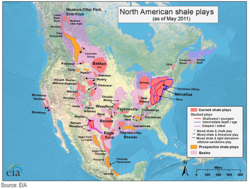Think of this as Volume 17, Number 38 of the newsletter I have written weekly since March, 1997. Enjoy.
 Even Noubar Afeyan, the MIT professor
Even Noubar Afeyan, the MIT professor
and entrepreneur I interviewed this week, does not believe it's
possible.
The idea of an energy glut is so
fantastic, so far outside normal business experience, as to be
inconceivable, he told me. Especially given the millions now entering
the global middle class in India, in Africa, and in Latin America. Of
course they'll want TVs and cars and the other trappings of American
life. They will compete financially to get them. And that will keep
energy prices high for at least a decade.
But the U.S. is already in an energy
glut. Natural gas prices here remain stubbornly below $4/mcf. The
“spread” between U.S. oil prices and global prices narrowed to a
few dollars recently, but has since expanded again. And E85 ethanol
(which actually contains just 15% alcohol) is priced at nearly 50
cents/gallon below the price of regular gasoline.
 The U.S. economic recovery, such as it
The U.S. economic recovery, such as it
is, has been driven by the creation of new energy. Shale oil, and
gas, has nearly made us energy independent, but the amount of solar
and wind energy in our grid has also increased dramatically, and the
cheapest form of renewable energy – efficiency – has kept demand
from growing. Costs across this energy front are going down,
continuously, and there is no reason to believe that this will
change.
Shale technology was pioneered by a man
I once interviewed, the late George Mitchell. He explained to me,
back in 1980, that conventional drilling only extracted half the oil
in a field. New technology could take out half of what remained. He
turned out to be right. There are enormous environmental challenges
in shale drilling, and the geology of overlying rock structures has
yet to be taken into account, but as a base technology it works.

Bakken, or Texas' Eagle Ford, can work just as well in Saudi Arabia.
In theory it can even work offshore, although I think the risks are
too great right now to go there. Especially since companies like
Norway's Statoil are still finding big pools of oil off the coasts of
Canada, and Brazil, and Angola. Especially since Iraq's oil is barely
being exploited, and Russia is now using new technology to more fully
exploit Siberia.
Critics note that shale drilling
carries enormous risks. But here's another hard fact. It's also very
expensive. Shale deposits are among the world's most expensive to
exploit, exceeded in base cost only by what Canada calls its “oil
sands,” which are really just bitumen that factories crush and mix
with natural gas liquids before dumping on hard-pressed refineries.
It's low quality, and carries a low price – margins are already
razor-thin.
Afeyan and I talked mainly about a
company he's backing, called Midori Renewables. Midori says it has a biocatalyst that can extract sugars from any
cellulosic fiber for pennies per pound. In theory, my son the
chemistry student explained, it's really pretty simple, since
cellulose and sugar consist of the same chemical compounds – break
the bonds of cellulose, as your own body breaks the bonds of starch,
and you get sugar, our primary biological fuel.

won't be interested in your biofuel start-up until you can get your
costs down well below $3/gallon. They want it to be as low as $2.40.
But KiOR, backed by Sun co-founder Vinod Khosla, has already gotten there,
and it's producing the equivalent of diesel oil from ordinary pine
pellets, in Columbus, Mississippi, at about that price.
Well, you think, if a company like KiOR
can make that work, others can too, so the cost of the needed biomass
would have to increase. They forget that the Columbus plant is just a
demonstration, that KiOR's biocatalysts – like Midori's – can
work on all forms of biomass.
Another way to increase the amount of
exploitable biomass is to plant something different. New types of
castor beans can grow during Brazil's dry season, without fertilizer,
during times when the soil is otherwise fallow, and their oil can
also be used as fuel. Evogene, an Israeli company, has demonstrated
just this.
What happens when you combine cheap
cellulosic alcohol, cheaper sugars, and new types of oil-producing
crops that don't damage the environment, with markets hungry for new
energy? You get even more downward pressure on oil and gas prices.

seeds of its own destruction. The last recovery was driven by cheap
money, meant to hide the costs of an illegitimate war, driving up
asset prices and causing banks to offer “liar loans” to millions,
around the world. The previous recovery, the Internet boom of the
1990s, was driven by unlimited supplies of new intelligence, which
eventually bumped against demand that could not keep up with it. The
recovery before that, in the 1980s, was birthed by low oil prices and
policies that made money more valuable, becoming vulnerable to the
higher prices of a new war and the ability of markets to destroy
money on a whim.
Our present path is most like that
“stagflation” decade of the 1970s, in which high oil prices
caused a boom in places like Houston, where I lived then, and a
long-lasting recession in places depending on trade and assets, such
as Atlanta, where I live now. Thirty years ago, when I was in the
market for a new house in Atlanta, the city was still recovering from
the impacts of that real estate collapse, and the previous decade's
white flight from the center city, so I was able to get into a lovely
home, next to a train station, for under $50,000, and the neighbors
thought I was being ripped-off.

1981, was also the peak of that decade's boom. Interest rates and oil
prices were heading down, and the Houston economy would take a decade
to recover from the blow.
In other words, energy booms carry
within them the seeds of their own collapse. I knew Houston was
heading for trouble in 1980, soon after talking with Mr. Mitchell,
when I listened to an economist describe how he'd created economic
models for that city based on rising, falling, and stable energy
prices, with each one showing a recession ahead. No one listened to
the warning I gave readers, any more than they listened to me 20
years later, when I warned about the coming dot-bomb.
There is currently an irrational
exuberance, across the oil patch, and throughout the energy sector,
based on a mistaken assumption that rising supplies will always get
their price, whatever it is. This defies economic logic. At some
point the fear of downward pressure becomes self-fulfilling.
Most of the oil market consists of
untapped reserves, and these reserves are the basis of the industry's
economics. They're assumed to be of increasing value, which is why
most remain untapped. Even the fear that this may change, that
reserves in the ground may be worth a little less next year than they
are this year, will be enough to set off a panic.
And that is going to happen. Not this
year, not next year, maybe not for another five years. Or, as Afeyan
thinks, 10 years. But it will happen, and I happen to think it will
be sooner rather than later, because markets are based on psychology,
and as we've seen throughout my life investor psychology can turn on
a dime.










